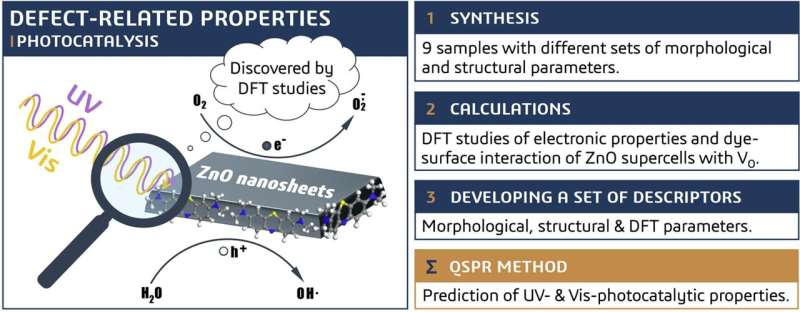
Chemists at St. Petersburg University have used big data analysis techniques to predict the photocatalytic properties of zinc oxide nanosheets, i.e. a nanostructured material consisting of particles in the form of thin sheets. The study aimed to solve the issue of waste-free degradation of organic dyes, which are widely used both in paint and textile industries. The research results and outcomes can also be applied for other similar environmental problems.
New materials development is an essential task of modern science. These materials can reduce harmful emissions into the biosphere and lower environmental pollution. New materials development is a complex and labor-intensive process. It includes several stages. Each stage is incredibly time-consuming and chances are that it may not provide the desired outcome.
Chemists must, first, synthesize a material; second, study its properties; and, finally, test it to see if the new material can solve a specific task. Scientists aim to simplify and accelerate this development process. Yet they have to understand first, even before they synthesize a substance, which properties to develop to make the substance more effective for solving a particular problem.
Scientists at St. Petersburg University have developed an approach for predicting the photocatalytic properties of zinc oxide nanosheets. The approach opens up broad prospects for the development of nanomaterials with the properties of interest that can be used, for example, to treat wastewater from dyes. The work is published in the journal Applied Surface Science.
The researchers used zinc oxide nanosheets as a photocatalyst, i.e. a material capable of degradation of organic dyes under visible light. Zinc oxide is non-toxic and simple in its production. Nano-sized particles have a larger surface area compared to a usual bulk material. As a result, dye degradation is faster and more efficient. It is the transition to the nanoscale that reveals the unique properties of many substances, including defect-related properties.
“Imagine, you have a completed Rubik’s cube with all the colors correctly matched. Now imagine that not only are the colors mixed up, but some parts are also missing. Yet, no matter how paradoxical it may sound, it is these defects that explain many interesting properties of semiconductor nanomaterials, including those that enable us to use zinc oxide nanosheets to solve environmental problems,” said Dmitry Tkachenko, a co-author of the study, a laboratory assistant and researcher in the Department of General and Inorganic Chemistry at St. Petersburg University.
The study had three stages. First, synthesizing zinc oxide nanosheets and describing their properties; second, considering the process of dye degradation at the molecular level; and, third, developing a model for predicting the photocatalyst efficiency.
“At the moment, it is not clear yet how we can regulate and determine the number of defects (mixed and missing colors in the Rubik’s cube) in nano-objects. However, in the course of the work, it was possible not only to find a way to regulate the number of such defects in nanosheets, but also to apply an original approach to predict them,” said Olga Osmolovskaya, Head of the group for the synthesis and study of nanoparticles and nanostructured materials, Associate Professor in the Department of General and Inorganic Chemistry at St. Petersburg University.
As a result, the chemists at St. Petersburg University obtained a set of parameters describing the structure and properties of zinc oxide nanosheets.
“The consideration of phenomena and processes in chemistry is often associated with an experiment in the laboratory, which requires a certain level of equipment and skills. We propose to use computer simulation, which does not require special and expensive equipment and has much greater capabilities and flexibility,” explained Mikhail Voznesenskiy, the author of the computational part of the study, associate professor in the Department of Physical Chemistry at St. Petersburg University.
As a result, from the entire set of parameters, the scientists selected those that had the greatest impact on the activity of the photocatalyst.
“Thus, we have developed a unique model to predict the efficiency of dye degradation in the presence of zinc oxide nanosheets. Now, any scientist, without conducting an experiment, can find out how effective a photocatalyst with certain parameters will be. This, in turn, opens up completely new opportunities in the development of nanomaterials with the properties in interest,” explained Dmitry Kirsanov, the author of the chemometric part of the study, professor in the Department of Analytical Chemistry at St. Petersburg University.
More information:
N.D. Kochnev et al, Regulation and prediction of defect-related properties in ZnO nanosheets: synthesis, morphological and structural parameters, DFT study and QSPR modelling, Applied Surface Science (2023). DOI: 10.1016/j.apsusc.2023.156828
Provided by
St. Petersburg State University

READ MORE
Researchers Turn Brains Transparent By Sucking Out the Fat
A new technique renders a mouse brain (opaque, at left) entirely transparent (at right) for [...]
Acoustofluidic centrifuge for nanoparticle enrichment and assortment
Operating mechanism of the acoustofluidic centrifuge platform. (A) Illustration of the acoustofluidic centrifuge system. The [...]
Young Picky Eaters May Be More Anxious and Depressed
Broccoli is a common foe of finicky young eaters. Mother Image/Caitie McCabe/mother image/Corbis Parents around [...]
Pushing back the limits of optical imaging by processing trillions of frames per second
The new device called SCARF (for swept-coded aperture real-time femtophotography) can capture transient absorption in [...]
UPDATED: Has the Voyager 1 Probe Finally Left the Solar System?
New data from the Voyager 1 probe, more than 11 billion miles away from the [...]
Caleb Cain Marcus’ Photos of Glaciers on a Disappearing Horizon
Perito Moreno, Plate I, 2010. Patagonia © Caleb Cain Marcus What happens when you lose [...]
Confinement effects of carbon nanotubes on polyoxometalate clusters enhance electrochemical energy storage
Schematic illustration and electron microscopy characterization of one-dimensional heterostructures of SWNT-confined polyoxometalate clusters. Credit: Wang [...]
Fabricating atomically-precise quantum antidots via vacancy self-assembly
Scanning tunneling microscopy image of an atomically-precise quantum antidot (QAD) self-assembled by 15 single tellurium [...]